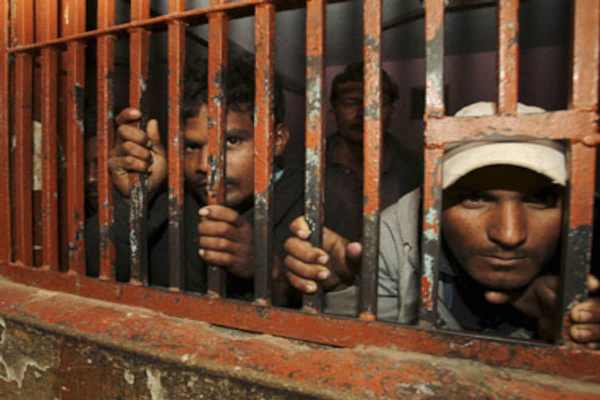Sweeping Judicial Reforms Are Necessary
ALSO READ: India’s Judiciary and India’s Security (Part 1)
There is so much wrong with our judiciary that it is difficult to enlist any aspect of it that is good. Judicial reforms along with police reforms and reforms in the bureaucracy are exigent as these organs of the government are negating all the good work any government attempts to implement.
Courts are custodians of India’s Constitution and Equality before law for all citizens is enshrined in that Constitution. Yet, it is the courts that favour the rich and powerful and pooh-pooh the poor, loudly violating the very Constitution they are charged to defend. Law is servant of the rich and master of the poor, here!
There are just too many laws in India. India has more laws than has physics!! While the current government has attempted to remove some of the archaic, obsolete and redundant laws, the courts have taken no such initiative. Apparently, more the laws, more is the income of lawyers.
Everything that could go wrong with India’s judiciary has gone wrong. The intake into the legal profession is from that stratum of society that has failed to get their prized vocations. Of these, the best lawyers opt out of the judiciary for pecuniary reasons. Of those that join the judiciary, promotions and lucrative postings are available only to the well-connected. With this as the pedigree of material manning our judiciary for near seven decades, it is small wonder our judicial system has gone to the dogs of the pariah variety. Some urgent and extraordinarily strong measures are required to remedy this appalling situation.
So, what is to be done ?
Option 1 – Improve the System
Sweeping judicial reforms are a crying necessity. All and any artificial attempt to put them on a pedestal needs to be removed. Instead of robes, judges should wear national dress, like our president does. Judges should be addressed as “Judge” or “Sir” or “Shriman” or “Madam”, “Mahodaya” or “Mahashaya”. Lawyers may wear black robes to distinguish them as officers of the court but they should not be called “Learned” or “Faazil”. They deserve respect not adulation or worship.
The states or districts that do not have their High Court or District Court yet must have one on priority. This should be incumbent when carving out a new state or a district. If bureaucrats ensure a chief secretary in every state and a district commissioner in every district, notwithstanding its size, why not a HC or a District Court? Vacancies in all courts should be filled up on war footing. Quality cannot be a hindrance as it has not been in the past.
Judicial promotions should be done from district level judges upwards. Lawyers who opt not to become judges at district level should not be eligible for being judges in HC or SC. The NJAC should be reenacted by the Sansad and a similar machinery formulated for appointing judges at district level.
Courts provide an essential service. They should work accordingly. Law Ministry must prescribe a set of norms to be followed by courts at all echelons. The maximum time permitted for various types of cases and trials, if not enshrined in the relevant Acts, should be laid down and strictly enforced. Failure to dispose-off a case within the time limit should invite “Contempt of Justice”, to be dealt with by the Sansad or the state legislature, the supreme body in any democracy. The phenomenon of “Contempt of Court” should be revoked. Other government officers, charged with equally important state functions, do not have such a weapon.
All appellate cases should be decided within a maximum of one month since all evidence and arguments are already recorded. If fresh evidence emerges, the case should be reverted to the trial court. Appeals should be decided on whether the evidence has been correctly interpreted by the lower court and whether the sentence is appropriate. There is no requirement to reexamine witnesses or exhume the whole case.
Retirement age of judges should be enhanced to 70 years. If pilots can fly till the age of 65, judges can surely perform sedentary jobs in the interest of disposing off lakhs of pending cases. Judges should clock-in about an hour before the court-time to prepare themselves for the day’s work, just like pilots, surgeons, pro-players and other responsible professionals do.
At present the court culture is to give dates for hearings for many cases in a day. In most cases the lawyers seek time on some flimsy ground or the other and no real work is done. The longer the case drags, the more the lawyers earn. There should be a financial penalty, like a traffic challan, for inordinate postponements or wastage of court’s time. Repeat offences should attract loss of licence-to-practice for the errant lawyers. A similar roster should be maintained for judges enumerating the number of hearings postponed by them along with reasons. Lethargic judges should be cautioned, reprimanded and ultimately sacked. Judiciary needs to be handled as one would handle any other sarkari organisation. No extra quarter needs to be given.
The tenure of CJI should also be of a fixed minimum duration so he/she can make meaningful contribution to the administration of justice in India. Having seven CJIs in six years (between 2014 and 2021), purely based on retirement age and seniority, reduces the post of CJI to a non-effective figurehead. No other hierarchical government organisation makes such a mockery of its topmost office. Letting more people retire as CJIs may be good for the people concerned but it is not good for the country.
The system can be improved only via a thorough overhaul. Judiciary should be declared as a Central Service with direct recruitment through an exam by UPSC. Since all candidates would be law graduates, the written exam should be designed to test the judicial acumen of the candidates, not just the knowledge of law. Those that clear the written exam should be sieved through an interview system akin to the Services Selection Board. The candidates should undergo intelligence tests, comprehension tests, personality tests, aptitude tests, physical tests and a medical exam.
The selected candidates should undergo a Judgeship Course of 3 to 6 months to orient them for a judicial career followed by an internship with senior judges for a few weeks. The newly inducted judges should start their career at the lowest rung, Judge Class III, and earn their promotions in a graded manner. Lateral induction of lawyers as judges should be permitted only to fill urgent vacancies and not otherwise. Promotion to District Judge should be based on time-scale and on performance. Promotion to HCs and SC should be based on a minimum qualifying service plus a promotion exam.
Reversal of judgments by appellate courts should earn a blackball for the concerned judge and repeated instances should block further promotion. Appointment of Chief Justices of HCs and SC should be based on seniority on an all-India basis with an assured minimum tenure of two years and a maximum of five years. The age of superannuation of judges should be 70 years, extendable to 72 years.
Being an all-India service and adjudicating the same law prevalent all over India, all judges should be posted to all parts of the country. No judge should spend more than three years in any court or a state. No judge should be posted in a home-town or a home state. This would automatically erode nepotism and prevent judges from developing “roots”. The posting of judges should be computer-controlled and strictly enforced except on extreme compassionate grounds.
IAS should be divested of all judicial functions. They are neither trained for them nor have the aptitude for judicial functions.
The judges should get the best compensation package in the country to prevent them from being lured by bribes and other inducements. A Judge Class III, the junior-most judge, should start with a salary of Rs 2 lakhs, furnished accommodation for family, conveyance for self and family, free education for children up to Class XII, domestic help, free medical care, free rail and air travel with family twice a year, etc. In short, the state should look after them as if they were IAS officers. The compensation of District Court, HC and SC judges should be proportionately increased. SC judges ought to earn around Rs 6 lakhs to make them inducement-free. No judge should have any reason to fall for any bait. As a counter-measure, any judge caught taking bribe or copping any undue influence should be held to the highest standards of public probity and dealt with strictly, swiftly and in an exemplary fashion. The normal punishment should be akin to cashiering, with rigorous imprisonment for a minimum of three years.
Law Ministry, in liaison with the SC, should draw up timelines to be followed by the courts and the judges to dispose-off various types of cases. All cases must be decided within the permitted time-lines. A wrong decision is far better than no decision. Timelines are a crying necessity for deciding cases. Not only are they in concert with the axiom of “Justice delayed is justice denied”, they reduce undertrials in prisons, costs of litigation and save precious time of the courts. What purpose, if any, is served by not deciding cases for decades, is something only our judges may understand. The load of lower courts can be reduced by delegation of all minor cases like traffic violations, petty family feuds, accidents, etc, that form 80 per cent of the 4.4 crore pending cases in India, to Gram Panchayats to decide.
Based on severity or the monetary value of the cases, these should be filed in designated tier of courts. Smallest cases to gram panchayats or Judge Class III courts, followed by courts of Judge Class II and Judge Class I – all at district level. HCs should be the basic appellate authority and be immune from initial filing of cases except cases involving state government machinery and high value transactions. Similarly, SC should only handle cases involving interpretation of law or the Constitution, cases involving constitutional appointments, inter-state disputes and appellate cases from HCs. All cases should be capped at two levels of appeals, terminating at the SC. So, a judgment of Judge Class III should go in appeal to Judge Class II and finally to Judge Class I. The verdict of Judge Class I in this case should be final. Similarly, a case initially decided by a Judge Class II should be appealable to Judge Class I and the HC only and so on.
Option 2 – Resort to Artificial Intelligence (AI)
Law is an emotionless phenomenon that works on the letter of the law and irrefutable evidence. In many ways it is robotic, like a computer. It, consequently, lends itself very favourably to computerisation. Artificial Intelligence (AI) could and should be used to replace the judicial function of the judges. Human judges should continue to hear arguments and examine evidence, as hither to fore. The court-clerk should then feed the evidence into the legal-software. The verdict and the sentence is decided by the computer, quite akin to the jury-system, where a judge plays no part in the verdict but decides the sentence. In the proposed system, the computer shall decide not only the verdict, it shall decide the quantum of punishment too.
Modern AI has reached unimaginable heights with pilotless aircraft, driverless cars, robotic industries, robot bartenders and waiters, right up to synthetic sex-dolls capable of near real-life experiences. A fair, unemotional and unperturbed AI-judiciary shall be a boon to the legal infrastructure. It shall eliminate all the ills of human-judges. Computers shall excel in recalling past judgments (precedences), cross-referencing various sections of the relevant laws, accept or reject legality of charges far better than human judges, in a swift and unbiased manner.
Computers cannot “interpret” law. So, SC shall require human judges for this important function. Even here, SC could and should use computers to sift, collate and present all the relevant facets of the law sought to be interpreted.

















